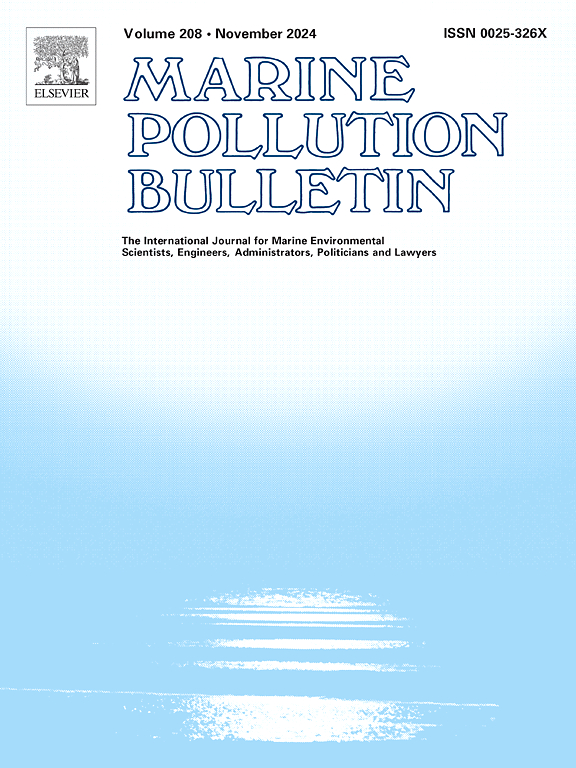Impact of offshore energy activities on trace elements content and mobility in marine sediments
IF 5.3
3区 环境科学与生态学
Q1 ENVIRONMENTAL SCIENCES
引用次数: 0
Abstract
The offshore oilfields in the North Sea area are increasingly employed for projects beyond oil production, like carbon capture and storage (CCS). Still, the fossil fuel production from mature fields is significant. It has raised environmental concerns associated with discharging produced waters (PW) and drilling mud into the sea. These discharges, which may be highly saline and contain production chemicals, vary significantly in metals and particulate content. Due to density and release depth, the plume is assumed to sink towards the seafloor. Also, a single oilfield can input up to 7.5 tons of Ba, 675 kg of Fe, and 619 kg of P into the water column through PW. Therefore, this study investigates the impact of these discharges on seafloor sediments around two Danish oilfields, assesses the mobility of metals within these sediments, and evaluates the environmental status. PW samples were collected at the discharge outlets from the platforms. Sediment cores were taken near the two oil platforms and from control sites. Using Inductively Coupled Plasma Mass Spectrometry (ICP-MS) and an optimized BCR sequential extraction, we analyzed the composition and distribution of 24 elements in sediment samples. The results revealed significant differences in total extracted concentrations between sediments near the platforms and those from distant locations and stratigraphically older samples, with relevant levels of Br, Ba, and Sn near the platforms (averaged 14, 27, and 0.1 ppb, respectively). Sediment quality indices showed considerable enrichment and geo-accumulation of toxic metals, particularly at one of the platform sites. However, cumulative indices did not display significant pollution anomalies. Therefore, our findings suggest that oil extraction activities may increase the availability of toxic metals in nearby sediments, potentially impacting marine ecosystems.
近海能源活动对海洋沉积物微量元素含量和流动性的影响
北海地区的海上油田越来越多地用于石油生产以外的项目,如碳捕集与封存(CCS)。尽管如此,成熟油田的化石燃料产量仍然很大。它引起了与排放采出水(PW)和钻井泥浆入海有关的环境问题。这些排放物可能含高盐并含有生产化学品,其金属和颗粒含量差异很大。由于密度和释放深度的关系,人们认为烟羽会向海底下沉。此外,单个油田可以通过PW向水柱中输入多达7.5吨Ba, 675千克Fe和619千克P。因此,本研究调查了这些排放物对丹麦两个油田周围海底沉积物的影响,评估了这些沉积物中金属的流动性,并评估了环境状况。在平台的排放口收集污水样本。沉积物岩心取自两个石油平台附近和对照地点。采用电感耦合等离子体质谱法(ICP-MS)和优化的BCR序列萃取法,分析了沉积物样品中24种元素的组成和分布。结果显示,台地附近沉积物的总萃取浓度与来自较远地点和地层较老样本的沉积物的总萃取浓度存在显著差异,台地附近的Br、Ba和Sn含量相关(平均分别为14、27和0.1 ppb)。沉积物质量指标显示有毒金属的富集和地质堆积,特别是在一个平台地点。然而,累积指数并未显示出显著的污染异常。因此,我们的研究结果表明,石油开采活动可能会增加附近沉积物中有毒金属的可用性,从而潜在地影响海洋生态系统。
本文章由计算机程序翻译,如有差异,请以英文原文为准。
求助全文
约1分钟内获得全文
求助全文
来源期刊

Marine pollution bulletin
环境科学-海洋与淡水生物学
CiteScore
10.20
自引率
15.50%
发文量
1077
审稿时长
68 days
期刊介绍:
Marine Pollution Bulletin is concerned with the rational use of maritime and marine resources in estuaries, the seas and oceans, as well as with documenting marine pollution and introducing new forms of measurement and analysis. A wide range of topics are discussed as news, comment, reviews and research reports, not only on effluent disposal and pollution control, but also on the management, economic aspects and protection of the marine environment in general.
 求助内容:
求助内容: 应助结果提醒方式:
应助结果提醒方式:


